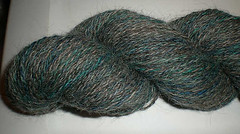In my experience (always a risky statement, but for the sake of disclosure, there it is), my singles fall apart when I'm plying because of low twist in the singles.
But wait, you say, didn't you just tell me I could ply low twist singles?
 Why yes, I did.
Why yes, I did.Let me clarify. First, yesterday's skein (aaah, I impressed myself with that one!) didn't drift apart, so I have no eye-pain of this phenomenon for you. If it's happened to you, you know what it looks like -- and how it feels.
Now then. Also, the singles fall apart from time to time, not all the time, right? At least, that's how it has been for me. Finally, recently, in reviewing my pluckyfluff study, I realized the cause. It's the same thing the county fair judge dings me on every year. Inconsistent Twist.
As you spin your singles, if the amount of twist in one length of singles doesn't match the amount of twist in the next length, then you get, Inconsistent Twist. Now, when you are spinning singles, your hands are doing alot. Alot. Drafting, letting twist up, picking out VM or neps, smoothing the surface of the yarn. And your feet are pedaling and your brain is wandering, and you may be talking or listening to something. There's alot going on!
When you ply, you have two nice, strong (you think!) singles, and you can just rip right through them. It's alot easier. Alot. And, it's muuuuch easier to get consistent twist during plying -- your yarns are fairly regular, and you can move along them at a regular clip. No drafting, no picking, just pull and pedal and wind on. (And remember to change hooks!)
So, if you singles have inconsistent twist and your plying has consistent twist, what happens? Most likely, your plying twist matches the median twist (how's that for throwing a heavy weight math term in there... hmmm, actually, the plying twist most likely matches the most prevalent twist in your yarn, which may not be the median ... but then again, I have to give the commenters something to discuss. Discuss away, I love to hear it all!) Anyway, as I was saying.
Most likely, your plying twist matches the amount of twist some length of your singles needs. If it's the low twist section, then you're okay and you ply away successfully. Of course, your final skein twists showing a need for more plying twist, but that's another problem. So, to continue, let's assume that's not the case.
Guess what -- as you add plying twist, you are removing singles twist. That's what spinning is! So, on the low twist sections of your singles, you may end up removing all the twist in one, or if you are supremely Murphy'd, both, single. And when all the twist is removed from the single, the tension you are keeping it under to keep it straight for the ply pulls it apart.
Whoosh! it flaps out, you find one of the singles not moving forward any more. You stop pedaling, the bobbin keeps turning and you fume silently (or not so silently) as you try to figure out why this is happening to you. Well, don't take it personally. It's happened to me. It's happened to most of us!
Once everything has calmed down (me included), I lay the separated single in on top of itself; I may try to put some twist in, especially if there's a high twist section of that single nearby. If they are on two bobbins or in two separate balls, I will try a bobbin variant of spindle splicing. If I'm worried, I may try some other type of join. Then I ply over the laid-in section and keep going. Lesson learned.
If there's something I can see as a cause -- like that underspun bit is also thicker -- then I'll try to apply that if I see a similar section coming up, to prevent it falling apart as well.
***
And for an earlier, less wordy discussion on this very same topic, see
Why are my singles separating during plying?
Questions or comments? Post on the blog or contact me. Thanks!
